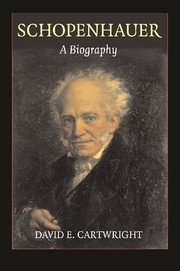Book contents
- Frontmatter
- Contents
- Preface
- Acknowledgments
- Notes on the Text
- Chronology of Schopenhauer's Life and Works
- 1 The Affirmation of the Will
- 2 A Tour for a Trade
- 3 A Father's Death; A Philosopher's Birth
- 4 The University Years
- 5 The Better Consciousness, Causes, Grounds, and Confrontations
- 6 Goethe, Colors, and Eastern Lights
- 7 The Single Thought of Dresden
- 8 Failure in Berlin
- 9 Ich Bin Kein Berliner
- 10 The Frankfurt Philosopher
- 11 The Dawn of Fame and the End of Life
- Works Cited
- Index
5 - The Better Consciousness, Causes, Grounds, and Confrontations
Published online by Cambridge University Press: 05 April 2014
- Frontmatter
- Contents
- Preface
- Acknowledgments
- Notes on the Text
- Chronology of Schopenhauer's Life and Works
- 1 The Affirmation of the Will
- 2 A Tour for a Trade
- 3 A Father's Death; A Philosopher's Birth
- 4 The University Years
- 5 The Better Consciousness, Causes, Grounds, and Confrontations
- 6 Goethe, Colors, and Eastern Lights
- 7 The Single Thought of Dresden
- 8 Failure in Berlin
- 9 Ich Bin Kein Berliner
- 10 The Frankfurt Philosopher
- 11 The Dawn of Fame and the End of Life
- Works Cited
- Index
Summary
Schopenhauer became a master of the art of distancing, both physically and psychologically. His first flight from Berlin – he would flee once again in 1831 – was to escape the effects of the unconscious ends expressed through the troops of Hegel's horse-riding world spirit. But history's goals lay elsewhere, and Napoleon did not attack Berlin. Thus, Schopenhauer's flight was not necessary. But he also practiced this art on himself, at an early age, if one trusts the reflections of the fifty-six-year-old philosopher: “There was a period in the years of my youth when I was constantly at pains to see myself from outside, and to picture them to myself; probably in order to make them enjoyable to me.” It was never enjoyable to be something, he would come to philosophize, but it was enjoyable to view things as they were, provided that one was uninvolved. To gaze down at the chaos below from a mountain top and to become a clear eye on the world below, forgetting oneself by no longer perceiving things as possible means to sate or frustrate desire, was to escape the dreamlike, or rather nightmare-like, world of coming-to-be and perishing. It was to become, as he later theorized, a timeless, will-less, painless subject of cognition, without a sense of either oneself or mundane things.
- Type
- Chapter
- Information
- SchopenhauerA Biography, pp. 180 - 238Publisher: Cambridge University PressPrint publication year: 2010



